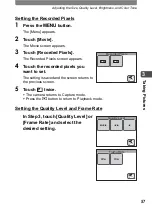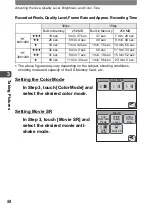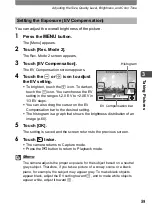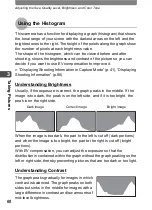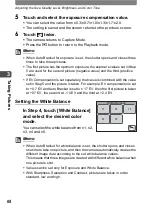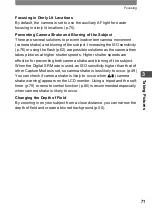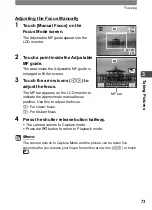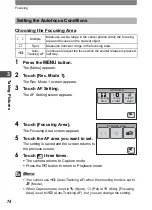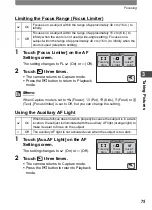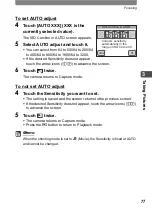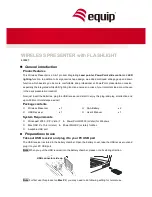
Adjusting the Size, Quality Level, Brightness, and Color Tone
63
3
Tak
ing P
icture
s
Memo
•
The approximate range of the flash is 0.15 m to 6 m when not using the
zoom (wide-angle setting) (factory default setting. The approximate range of
the flash is 0.4 m to 3 m when using the 3× optical zoom (telephoto setting)).
If the subject is too far from the camera, it will not be illuminated by the flash.
Additionally, if the subject is too close to the camera, exposure will not be
correctly adjusted. Increase the ISO sensitivity (p.76) to extend the effective
range of the flash.
•
You can also increase the ISO sensitivity setting to take pictures in dimly lit
locations without using the flash. When the ISO sensitivity is increased, the
shutter speed also increases, making it easier to prevent camera shake and
blurring of the subject. However, you may notice increased noise, which
looks like a grainy pattern, in the picture (p.76).
•
The flash mode is fixed at
a
(Flash Off) when the shooting mode is set to
C
(Movie), the drive mode is set to
1
(Cont. Shooting), the Auto Bracket
is set to
l
(Exposure), or the focus mode is set to
s
(Infinity).
•
Taking pictures using the flash in dark locations may cause the subject’s
eyes to appear red in the resulting picture. This phenomenon occurs when
the light from the flash is reflected in the subject’s eyes. Setting the flash
mode to
c
(Auto + Red-eye) or
d
(Flash On + Red-eye) is an effective way
of preventing red eyes. It can be also reduced by illuminating the area
around the subject or moving closer to the subject and zooming out. If the
subject’s eyes still appear red despite such precautions, they can be
corrected by the red-eye compensation function later (p.128).
•
Pre-flashes discharge when the flash mode is set to
c
(Auto + Red-eye) or
d
(Flash On + Red-eye).









